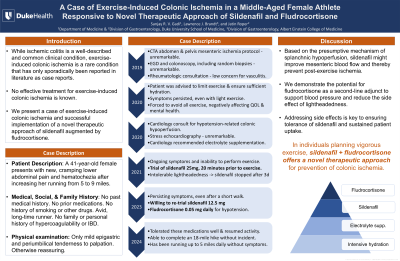Monday Poster Session
Category: GI Bleeding
P2515 - A Case of Exercise-Induced Colonic Ischemia in a Middle-Aged Female Athlete Responsive to Novel Therapeutic Approach of Sildenafil and Fludrocortisone
Monday, October 28, 2024
10:30 AM - 4:00 PM ET
Location: Exhibit Hall E

Has Audio

Sanjay Gadi, MD
Duke University Medical Center
Durham, NC
Presenting Author(s)
Sanjay Gadi, MD1, Lawrence J. Brandt, MD, MACG2, Jatin Roper, MD3
1Duke University Medical Center, Durham, NC; 2Albert Einstein College of Medicine, Bronx, NY; 3Duke University School of Medicine, Durham, NC
Introduction: Vigorous exercise is a rare cause of colonic ischemia, and no effective treatment has previously been reported. We present a case of exercise-induced abdominal pain and hematochezia thought to be non-occlusive ischemic colitis treated successfully with sildenafil and fludrocortisone.
Case Description/Methods: A 41-year-old longtime runner with no medical history presents for evaluation of new cramping lower abdominal pain and hematochezia after increasing her run distance from 5 miles to 9 miles. Physical examination only revealed mild periumbilical tenderness. She denies family or personal history of hypercoagulability or IBD. CTA did not show mesenteric ischemia. Upper endoscopy and colonoscopy were unrevealing. Rheumatologic consultation reassured against vasculitis. Stress echocardiography was normal. A presumptive diagnosis of exercise-induced colonic ischemia was made. She was advised to limit exercise and ensure proper hydration, but given persisting symptoms, a trial of sildenafil 25 mg prior to exercise was offered. Given intolerance due to lightheadedness, her dose was reduced to 12.5 mg combined with intensive hydration. Fludrocortisone 0.05 mg daily was added to address hypotension. She tolerated these medications well, reported near resolution of her symptoms, and successfully returned to her usual exercise frequency and intensity.
Discussion: We present a patient with recurrent exercise-induced colonic ischemia based on her presentation of crampy abdominal pain and hematochezia after exercise. Based on the presumptive mechanism of splanchnic hypoperfusion, we hypothesized that sildenafil might improve mesenteric blood flow in our patient and consequently prevent ischemic episodes after exercise. Treatment with 12.5 mg sildenafil 30 minutes prior to exercise, together with intensive hydration, electrolyte supplementation, and fludrocortisone to maintain blood pressure, successfully prevented symptoms of colonic ischemia. While aggressive hydration and electrolyte supplementation represent first-line adjunctive measures to address hypotension, we demonstrate the potential for fludrocortisone as a second-line option to support blood pressure and reduce the side effect of lightheadedness. Addressing such side effects is likely key to ensuring tolerance of sildenafil and sustained patient uptake. In conclusion, medical management with sildenafil, fludrocortisone, and hydration offers a new therapeutic option for prevention of colonic ischemia in individuals planning vigorous exercise.
Disclosures:
Sanjay Gadi, MD1, Lawrence J. Brandt, MD, MACG2, Jatin Roper, MD3. P2515 - A Case of Exercise-Induced Colonic Ischemia in a Middle-Aged Female Athlete Responsive to Novel Therapeutic Approach of Sildenafil and Fludrocortisone, ACG 2024 Annual Scientific Meeting Abstracts. Philadelphia, PA: American College of Gastroenterology.
1Duke University Medical Center, Durham, NC; 2Albert Einstein College of Medicine, Bronx, NY; 3Duke University School of Medicine, Durham, NC
Introduction: Vigorous exercise is a rare cause of colonic ischemia, and no effective treatment has previously been reported. We present a case of exercise-induced abdominal pain and hematochezia thought to be non-occlusive ischemic colitis treated successfully with sildenafil and fludrocortisone.
Case Description/Methods: A 41-year-old longtime runner with no medical history presents for evaluation of new cramping lower abdominal pain and hematochezia after increasing her run distance from 5 miles to 9 miles. Physical examination only revealed mild periumbilical tenderness. She denies family or personal history of hypercoagulability or IBD. CTA did not show mesenteric ischemia. Upper endoscopy and colonoscopy were unrevealing. Rheumatologic consultation reassured against vasculitis. Stress echocardiography was normal. A presumptive diagnosis of exercise-induced colonic ischemia was made. She was advised to limit exercise and ensure proper hydration, but given persisting symptoms, a trial of sildenafil 25 mg prior to exercise was offered. Given intolerance due to lightheadedness, her dose was reduced to 12.5 mg combined with intensive hydration. Fludrocortisone 0.05 mg daily was added to address hypotension. She tolerated these medications well, reported near resolution of her symptoms, and successfully returned to her usual exercise frequency and intensity.
Discussion: We present a patient with recurrent exercise-induced colonic ischemia based on her presentation of crampy abdominal pain and hematochezia after exercise. Based on the presumptive mechanism of splanchnic hypoperfusion, we hypothesized that sildenafil might improve mesenteric blood flow in our patient and consequently prevent ischemic episodes after exercise. Treatment with 12.5 mg sildenafil 30 minutes prior to exercise, together with intensive hydration, electrolyte supplementation, and fludrocortisone to maintain blood pressure, successfully prevented symptoms of colonic ischemia. While aggressive hydration and electrolyte supplementation represent first-line adjunctive measures to address hypotension, we demonstrate the potential for fludrocortisone as a second-line option to support blood pressure and reduce the side effect of lightheadedness. Addressing such side effects is likely key to ensuring tolerance of sildenafil and sustained patient uptake. In conclusion, medical management with sildenafil, fludrocortisone, and hydration offers a new therapeutic option for prevention of colonic ischemia in individuals planning vigorous exercise.
Disclosures:
Sanjay Gadi indicated no relevant financial relationships.
Lawrence Brandt indicated no relevant financial relationships.
Jatin Roper indicated no relevant financial relationships.
Sanjay Gadi, MD1, Lawrence J. Brandt, MD, MACG2, Jatin Roper, MD3. P2515 - A Case of Exercise-Induced Colonic Ischemia in a Middle-Aged Female Athlete Responsive to Novel Therapeutic Approach of Sildenafil and Fludrocortisone, ACG 2024 Annual Scientific Meeting Abstracts. Philadelphia, PA: American College of Gastroenterology.
